Factors Affecting Supply Chain Transparency: Australian SME Case Study
VerifiedAdded on 2023/06/04
|30
|7878
|403
Report
AI Summary
This report provides a comprehensive analysis of supply chain transparency within the context of waste management, specifically focusing on an Australian SME case study. The study explores the significance of business process transparency, emphasizing its impact on stakeholder management, both internal and external, and highlighting the crucial role of information technology in fostering transparency. The research employs a qualitative methodology, utilizing secondary data sources such as articles, journals, and books to examine the challenges and opportunities related to transparency. The findings underscore the importance of maintaining transparency for smooth business operations, particularly for SMEs, and the consequences of overlooking IT upgrades. The report also delves into supply chain transparency, emphasizing the need for clear communication with suppliers and other departments. The conclusion offers recommendations for enhancing transparency, recognizing its ethical and sustainable implications. The report's structure includes an executive summary, literature review, methodology, findings, discussion, and conclusion, providing a detailed understanding of the subject matter. The study focuses on a Sydney based SME named SVSR PTY LTD, which deals with sewer venting facilities and mini crane hire services, and the report provides solutions to the challenges faced by the company. The report is Harvard referenced and follows the specified formatting guidelines, including font size, spacing, and report structure, as per the assignment brief.
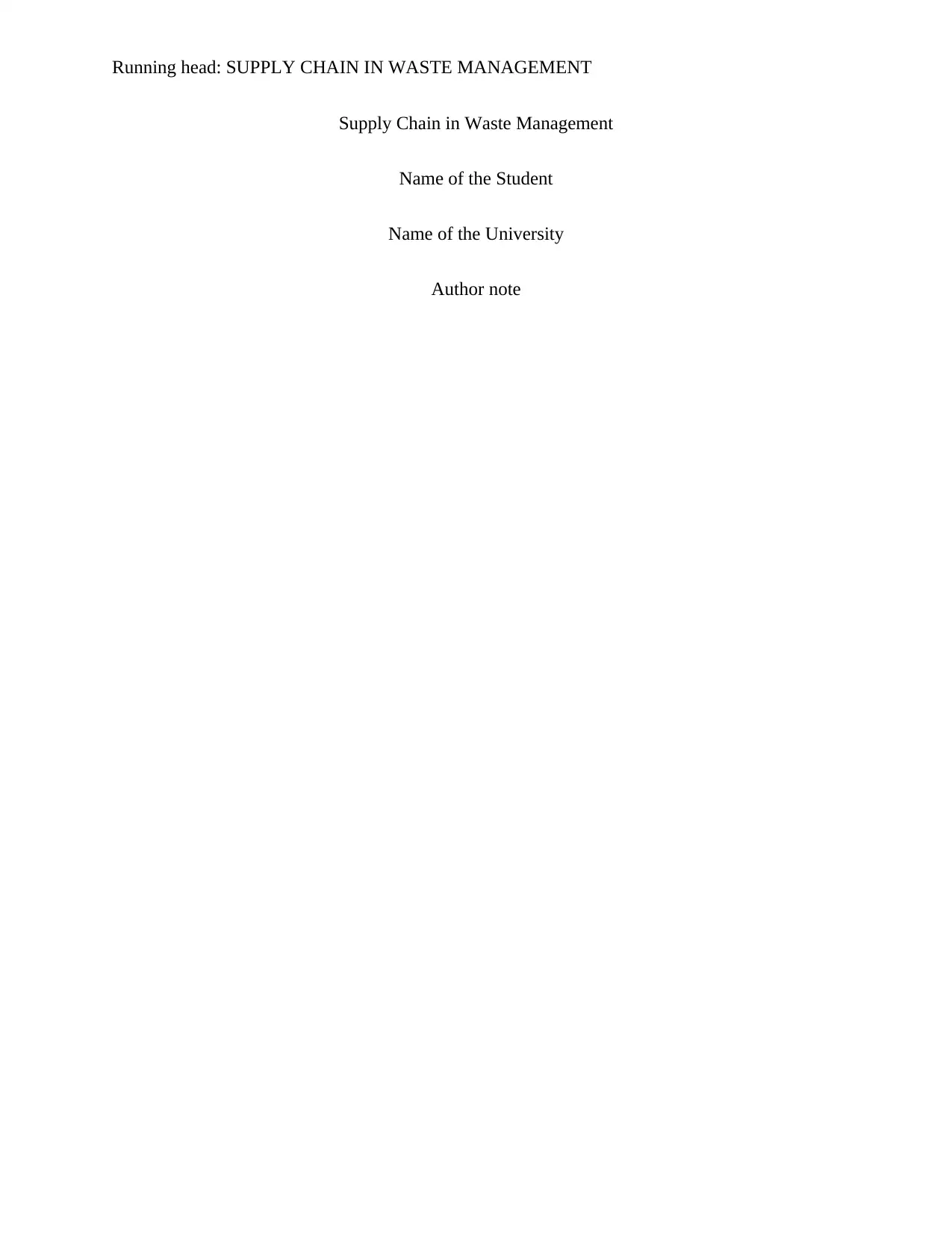
Running head: SUPPLY CHAIN IN WASTE MANAGEMENT
Supply Chain in Waste Management
Name of the Student
Name of the University
Author note
Supply Chain in Waste Management
Name of the Student
Name of the University
Author note
Paraphrase This Document
Need a fresh take? Get an instant paraphrase of this document with our AI Paraphraser
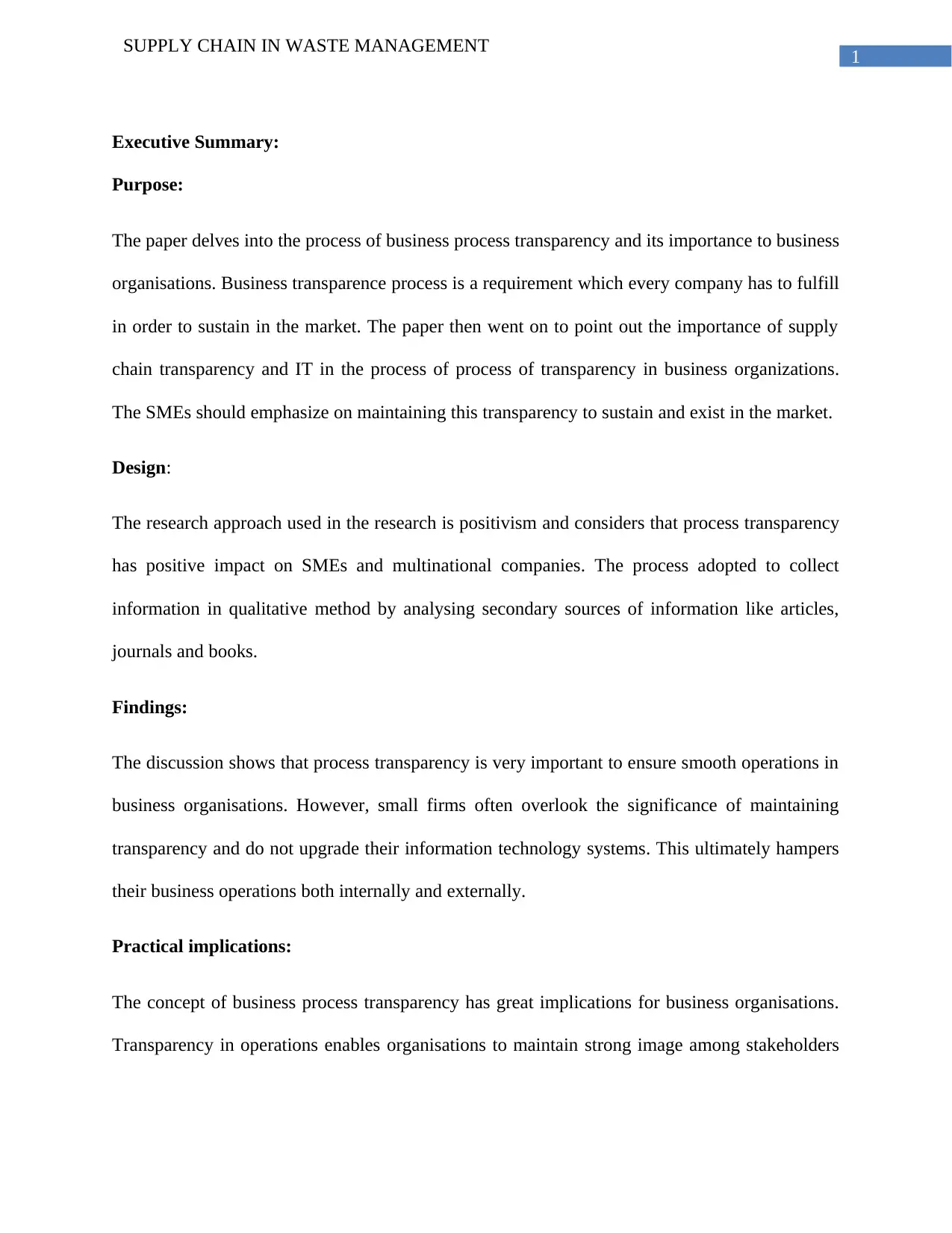
1
SUPPLY CHAIN IN WASTE MANAGEMENT
Executive Summary:
Purpose:
The paper delves into the process of business process transparency and its importance to business
organisations. Business transparence process is a requirement which every company has to fulfill
in order to sustain in the market. The paper then went on to point out the importance of supply
chain transparency and IT in the process of process of transparency in business organizations.
The SMEs should emphasize on maintaining this transparency to sustain and exist in the market.
Design:
The research approach used in the research is positivism and considers that process transparency
has positive impact on SMEs and multinational companies. The process adopted to collect
information in qualitative method by analysing secondary sources of information like articles,
journals and books.
Findings:
The discussion shows that process transparency is very important to ensure smooth operations in
business organisations. However, small firms often overlook the significance of maintaining
transparency and do not upgrade their information technology systems. This ultimately hampers
their business operations both internally and externally.
Practical implications:
The concept of business process transparency has great implications for business organisations.
Transparency in operations enables organisations to maintain strong image among stakeholders
SUPPLY CHAIN IN WASTE MANAGEMENT
Executive Summary:
Purpose:
The paper delves into the process of business process transparency and its importance to business
organisations. Business transparence process is a requirement which every company has to fulfill
in order to sustain in the market. The paper then went on to point out the importance of supply
chain transparency and IT in the process of process of transparency in business organizations.
The SMEs should emphasize on maintaining this transparency to sustain and exist in the market.
Design:
The research approach used in the research is positivism and considers that process transparency
has positive impact on SMEs and multinational companies. The process adopted to collect
information in qualitative method by analysing secondary sources of information like articles,
journals and books.
Findings:
The discussion shows that process transparency is very important to ensure smooth operations in
business organisations. However, small firms often overlook the significance of maintaining
transparency and do not upgrade their information technology systems. This ultimately hampers
their business operations both internally and externally.
Practical implications:
The concept of business process transparency has great implications for business organisations.
Transparency in operations enables organisations to maintain strong image among stakeholders
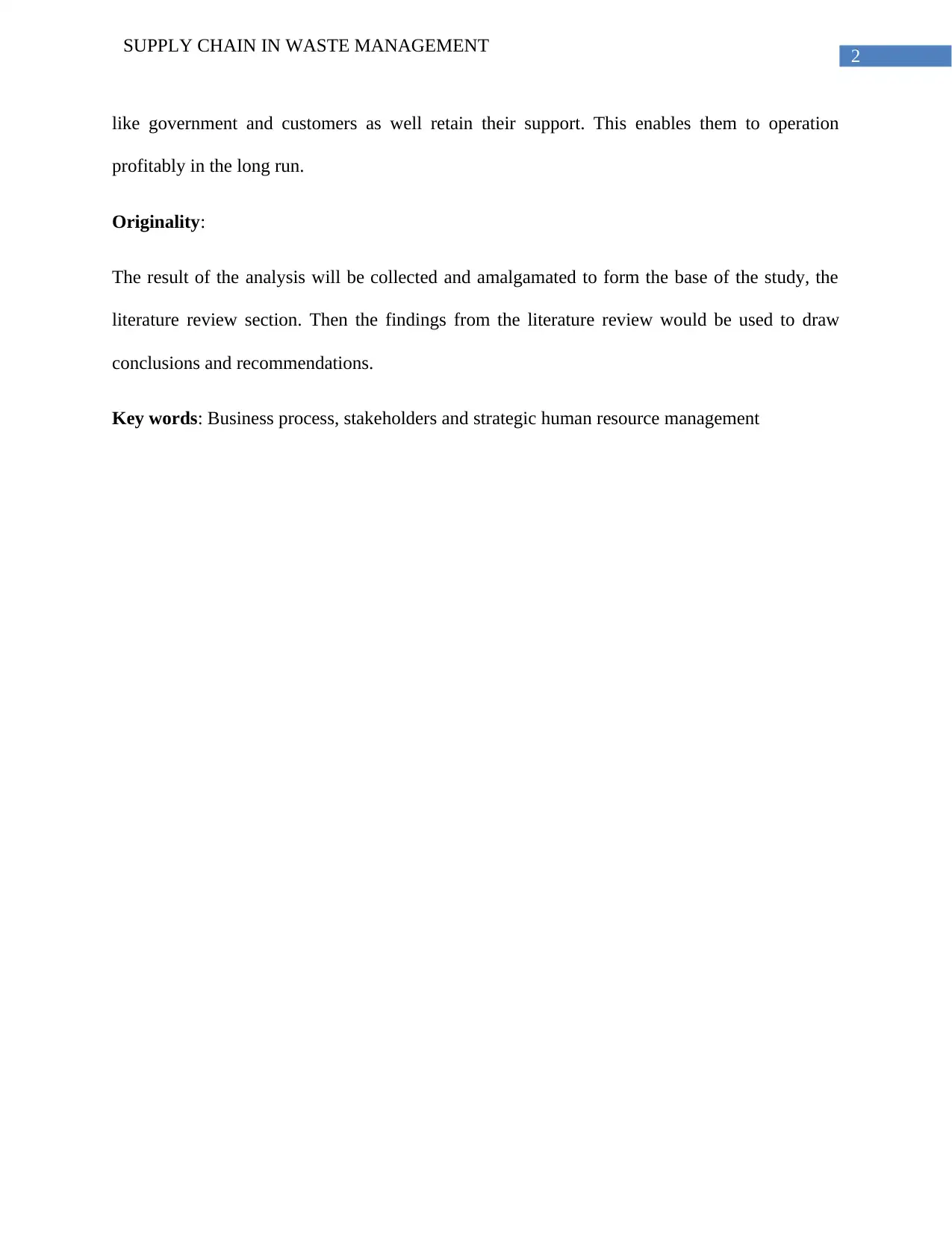
2
SUPPLY CHAIN IN WASTE MANAGEMENT
like government and customers as well retain their support. This enables them to operation
profitably in the long run.
Originality:
The result of the analysis will be collected and amalgamated to form the base of the study, the
literature review section. Then the findings from the literature review would be used to draw
conclusions and recommendations.
Key words: Business process, stakeholders and strategic human resource management
SUPPLY CHAIN IN WASTE MANAGEMENT
like government and customers as well retain their support. This enables them to operation
profitably in the long run.
Originality:
The result of the analysis will be collected and amalgamated to form the base of the study, the
literature review section. Then the findings from the literature review would be used to draw
conclusions and recommendations.
Key words: Business process, stakeholders and strategic human resource management
⊘ This is a preview!⊘
Do you want full access?
Subscribe today to unlock all pages.

Trusted by 1+ million students worldwide
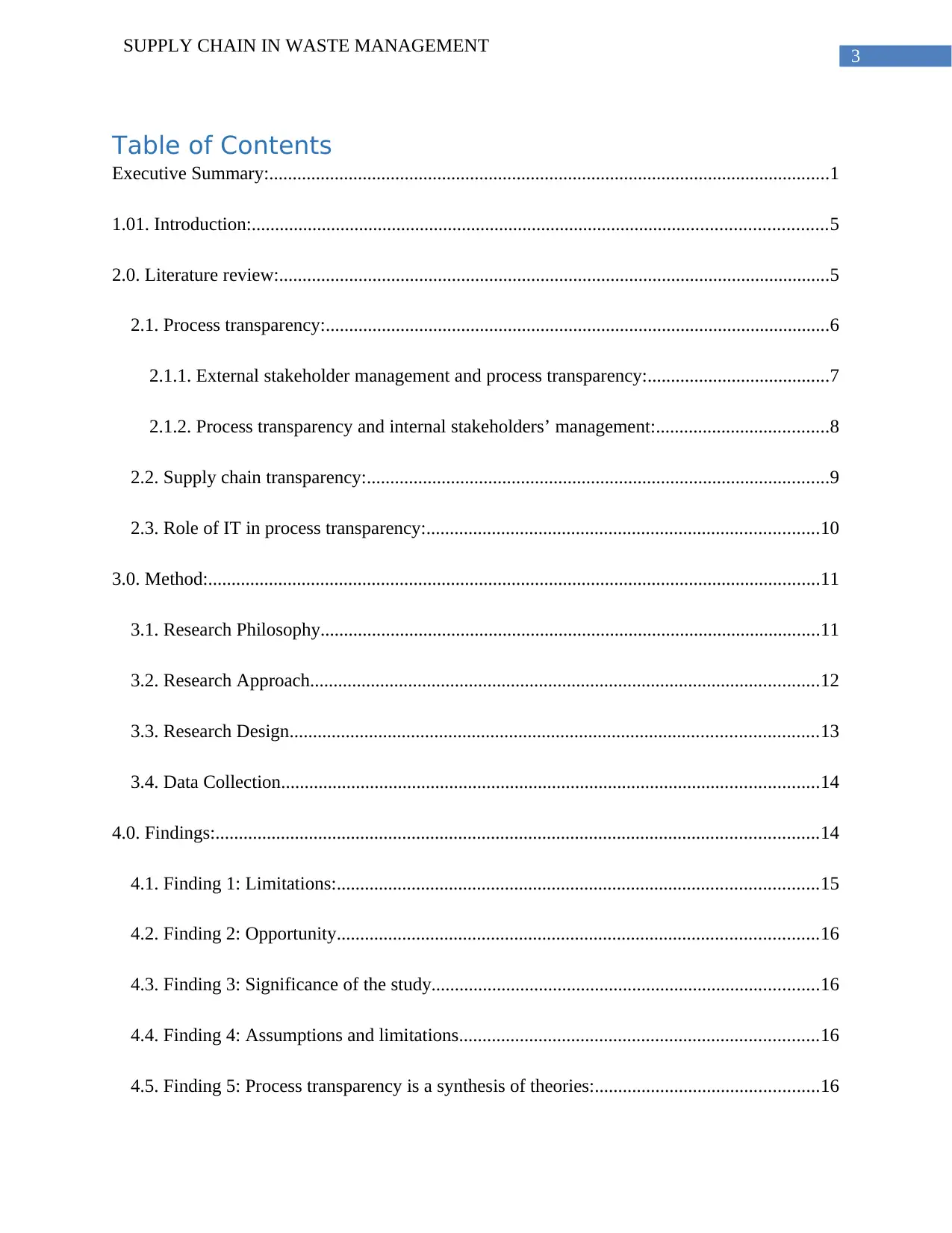
3
SUPPLY CHAIN IN WASTE MANAGEMENT
Table of Contents
Executive Summary:........................................................................................................................1
1.01. Introduction:...........................................................................................................................5
2.0. Literature review:......................................................................................................................5
2.1. Process transparency:............................................................................................................6
2.1.1. External stakeholder management and process transparency:.......................................7
2.1.2. Process transparency and internal stakeholders’ management:.....................................8
2.2. Supply chain transparency:...................................................................................................9
2.3. Role of IT in process transparency:....................................................................................10
3.0. Method:...................................................................................................................................11
3.1. Research Philosophy...........................................................................................................11
3.2. Research Approach.............................................................................................................12
3.3. Research Design.................................................................................................................13
3.4. Data Collection...................................................................................................................14
4.0. Findings:.................................................................................................................................14
4.1. Finding 1: Limitations:.......................................................................................................15
4.2. Finding 2: Opportunity.......................................................................................................16
4.3. Finding 3: Significance of the study...................................................................................16
4.4. Finding 4: Assumptions and limitations.............................................................................16
4.5. Finding 5: Process transparency is a synthesis of theories:................................................16
SUPPLY CHAIN IN WASTE MANAGEMENT
Table of Contents
Executive Summary:........................................................................................................................1
1.01. Introduction:...........................................................................................................................5
2.0. Literature review:......................................................................................................................5
2.1. Process transparency:............................................................................................................6
2.1.1. External stakeholder management and process transparency:.......................................7
2.1.2. Process transparency and internal stakeholders’ management:.....................................8
2.2. Supply chain transparency:...................................................................................................9
2.3. Role of IT in process transparency:....................................................................................10
3.0. Method:...................................................................................................................................11
3.1. Research Philosophy...........................................................................................................11
3.2. Research Approach.............................................................................................................12
3.3. Research Design.................................................................................................................13
3.4. Data Collection...................................................................................................................14
4.0. Findings:.................................................................................................................................14
4.1. Finding 1: Limitations:.......................................................................................................15
4.2. Finding 2: Opportunity.......................................................................................................16
4.3. Finding 3: Significance of the study...................................................................................16
4.4. Finding 4: Assumptions and limitations.............................................................................16
4.5. Finding 5: Process transparency is a synthesis of theories:................................................16
Paraphrase This Document
Need a fresh take? Get an instant paraphrase of this document with our AI Paraphraser
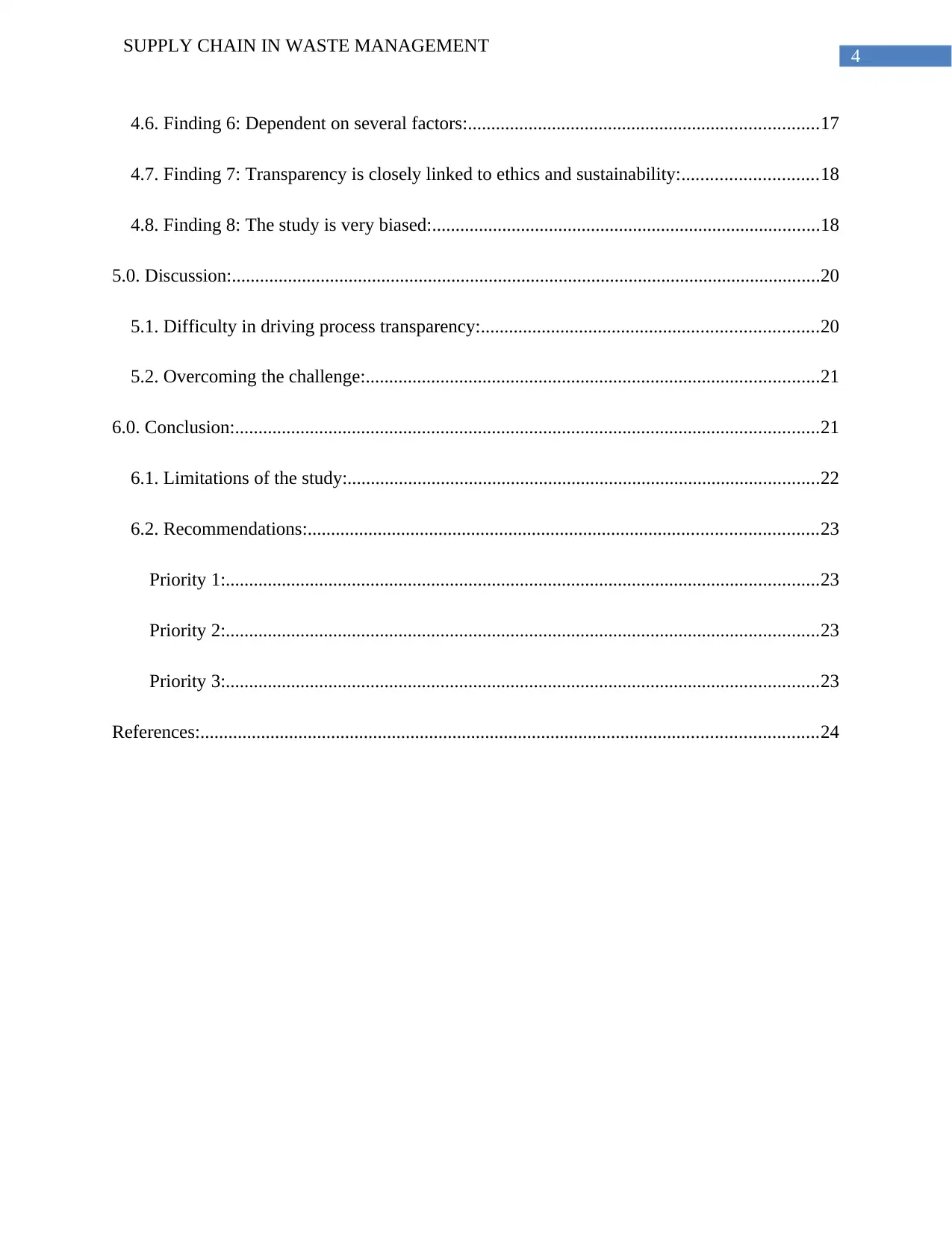
4
SUPPLY CHAIN IN WASTE MANAGEMENT
4.6. Finding 6: Dependent on several factors:...........................................................................17
4.7. Finding 7: Transparency is closely linked to ethics and sustainability:.............................18
4.8. Finding 8: The study is very biased:...................................................................................18
5.0. Discussion:..............................................................................................................................20
5.1. Difficulty in driving process transparency:........................................................................20
5.2. Overcoming the challenge:.................................................................................................21
6.0. Conclusion:.............................................................................................................................21
6.1. Limitations of the study:.....................................................................................................22
6.2. Recommendations:.............................................................................................................23
Priority 1:...............................................................................................................................23
Priority 2:...............................................................................................................................23
Priority 3:...............................................................................................................................23
References:....................................................................................................................................24
SUPPLY CHAIN IN WASTE MANAGEMENT
4.6. Finding 6: Dependent on several factors:...........................................................................17
4.7. Finding 7: Transparency is closely linked to ethics and sustainability:.............................18
4.8. Finding 8: The study is very biased:...................................................................................18
5.0. Discussion:..............................................................................................................................20
5.1. Difficulty in driving process transparency:........................................................................20
5.2. Overcoming the challenge:.................................................................................................21
6.0. Conclusion:.............................................................................................................................21
6.1. Limitations of the study:.....................................................................................................22
6.2. Recommendations:.............................................................................................................23
Priority 1:...............................................................................................................................23
Priority 2:...............................................................................................................................23
Priority 3:...............................................................................................................................23
References:....................................................................................................................................24
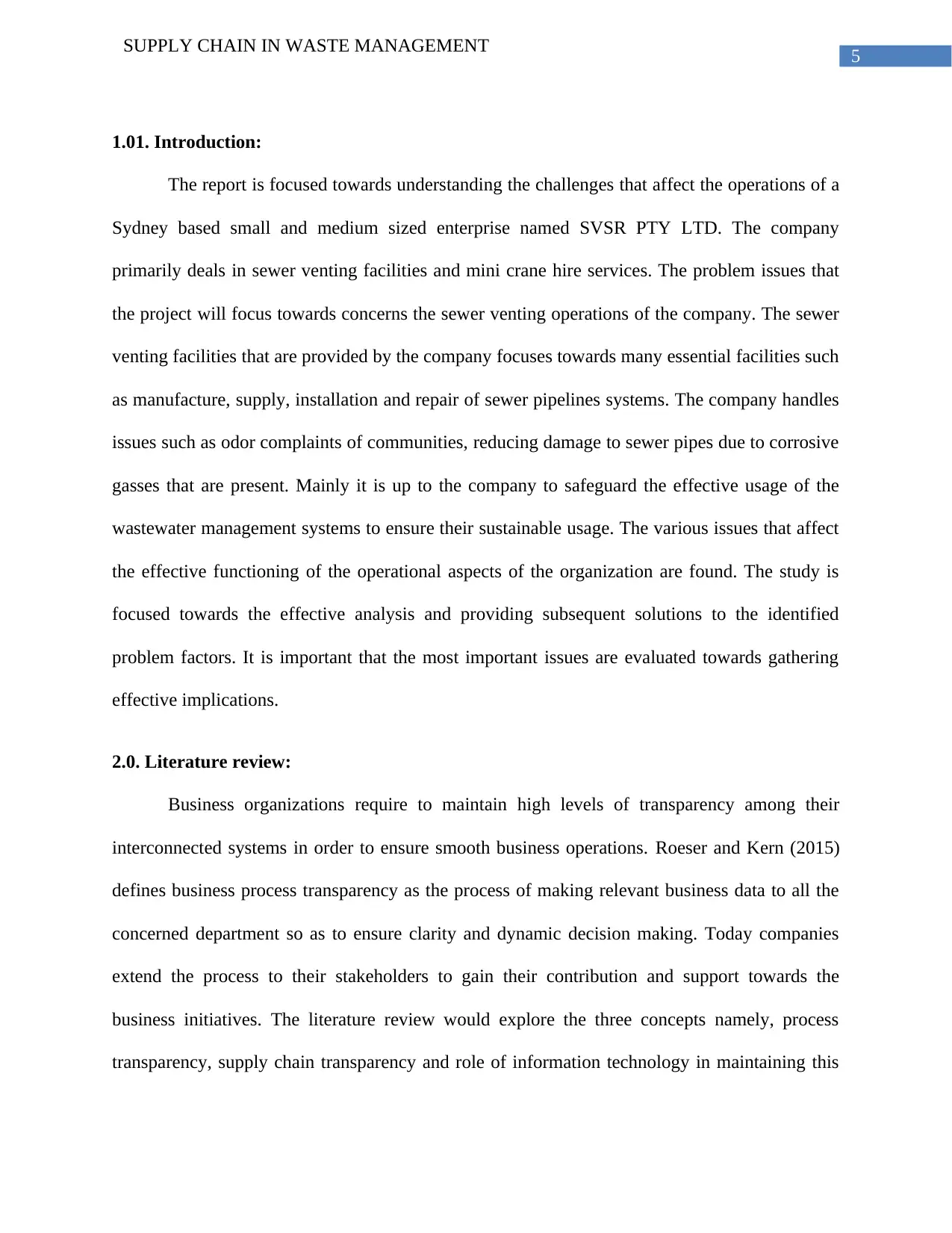
5
SUPPLY CHAIN IN WASTE MANAGEMENT
1.01. Introduction:
The report is focused towards understanding the challenges that affect the operations of a
Sydney based small and medium sized enterprise named SVSR PTY LTD. The company
primarily deals in sewer venting facilities and mini crane hire services. The problem issues that
the project will focus towards concerns the sewer venting operations of the company. The sewer
venting facilities that are provided by the company focuses towards many essential facilities such
as manufacture, supply, installation and repair of sewer pipelines systems. The company handles
issues such as odor complaints of communities, reducing damage to sewer pipes due to corrosive
gasses that are present. Mainly it is up to the company to safeguard the effective usage of the
wastewater management systems to ensure their sustainable usage. The various issues that affect
the effective functioning of the operational aspects of the organization are found. The study is
focused towards the effective analysis and providing subsequent solutions to the identified
problem factors. It is important that the most important issues are evaluated towards gathering
effective implications.
2.0. Literature review:
Business organizations require to maintain high levels of transparency among their
interconnected systems in order to ensure smooth business operations. Roeser and Kern (2015)
defines business process transparency as the process of making relevant business data to all the
concerned department so as to ensure clarity and dynamic decision making. Today companies
extend the process to their stakeholders to gain their contribution and support towards the
business initiatives. The literature review would explore the three concepts namely, process
transparency, supply chain transparency and role of information technology in maintaining this
SUPPLY CHAIN IN WASTE MANAGEMENT
1.01. Introduction:
The report is focused towards understanding the challenges that affect the operations of a
Sydney based small and medium sized enterprise named SVSR PTY LTD. The company
primarily deals in sewer venting facilities and mini crane hire services. The problem issues that
the project will focus towards concerns the sewer venting operations of the company. The sewer
venting facilities that are provided by the company focuses towards many essential facilities such
as manufacture, supply, installation and repair of sewer pipelines systems. The company handles
issues such as odor complaints of communities, reducing damage to sewer pipes due to corrosive
gasses that are present. Mainly it is up to the company to safeguard the effective usage of the
wastewater management systems to ensure their sustainable usage. The various issues that affect
the effective functioning of the operational aspects of the organization are found. The study is
focused towards the effective analysis and providing subsequent solutions to the identified
problem factors. It is important that the most important issues are evaluated towards gathering
effective implications.
2.0. Literature review:
Business organizations require to maintain high levels of transparency among their
interconnected systems in order to ensure smooth business operations. Roeser and Kern (2015)
defines business process transparency as the process of making relevant business data to all the
concerned department so as to ensure clarity and dynamic decision making. Today companies
extend the process to their stakeholders to gain their contribution and support towards the
business initiatives. The literature review would explore the three concepts namely, process
transparency, supply chain transparency and role of information technology in maintaining this
⊘ This is a preview!⊘
Do you want full access?
Subscribe today to unlock all pages.

Trusted by 1+ million students worldwide
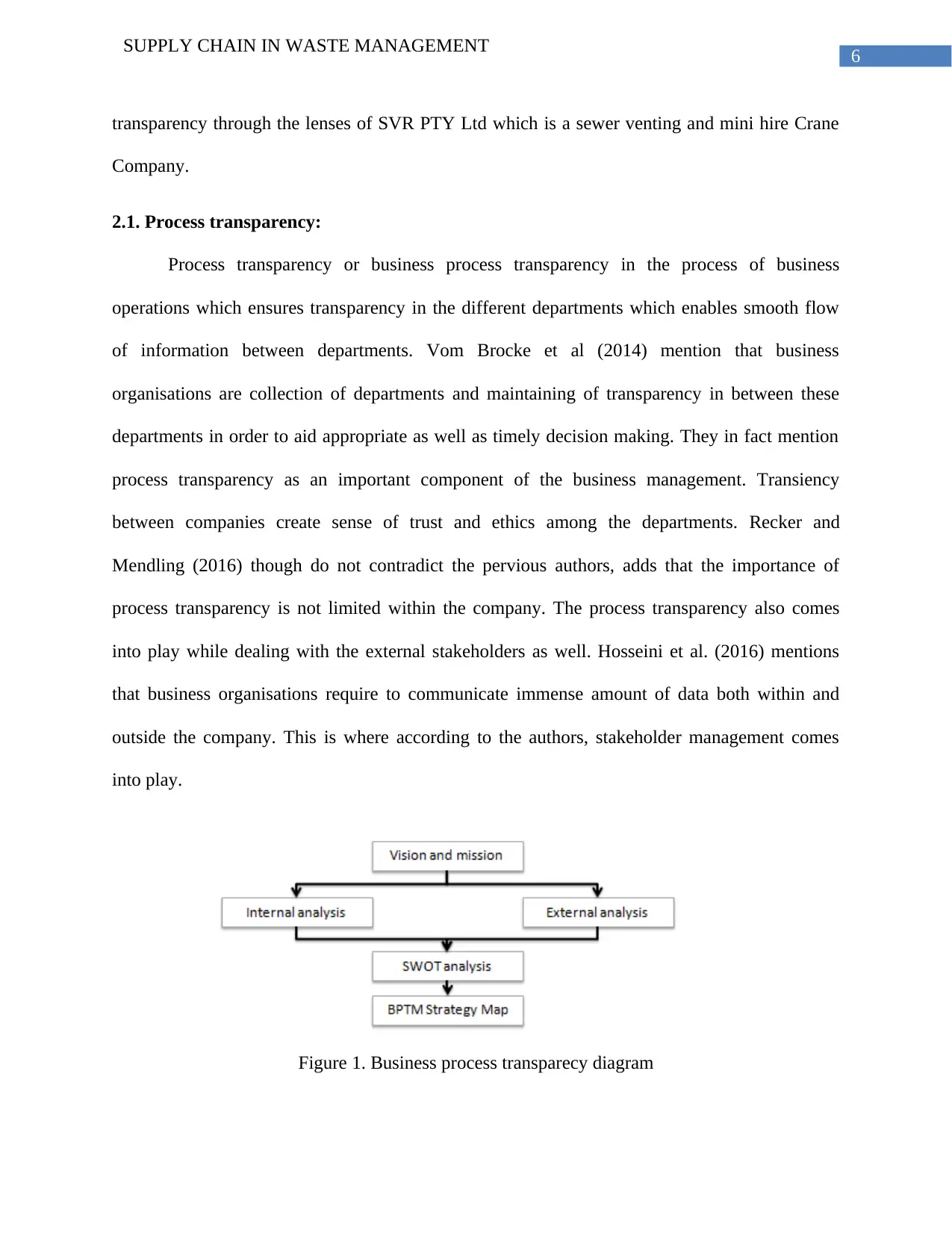
6
SUPPLY CHAIN IN WASTE MANAGEMENT
transparency through the lenses of SVR PTY Ltd which is a sewer venting and mini hire Crane
Company.
2.1. Process transparency:
Process transparency or business process transparency in the process of business
operations which ensures transparency in the different departments which enables smooth flow
of information between departments. Vom Brocke et al (2014) mention that business
organisations are collection of departments and maintaining of transparency in between these
departments in order to aid appropriate as well as timely decision making. They in fact mention
process transparency as an important component of the business management. Transiency
between companies create sense of trust and ethics among the departments. Recker and
Mendling (2016) though do not contradict the pervious authors, adds that the importance of
process transparency is not limited within the company. The process transparency also comes
into play while dealing with the external stakeholders as well. Hosseini et al. (2016) mentions
that business organisations require to communicate immense amount of data both within and
outside the company. This is where according to the authors, stakeholder management comes
into play.
Figure 1. Business process transparecy diagram
SUPPLY CHAIN IN WASTE MANAGEMENT
transparency through the lenses of SVR PTY Ltd which is a sewer venting and mini hire Crane
Company.
2.1. Process transparency:
Process transparency or business process transparency in the process of business
operations which ensures transparency in the different departments which enables smooth flow
of information between departments. Vom Brocke et al (2014) mention that business
organisations are collection of departments and maintaining of transparency in between these
departments in order to aid appropriate as well as timely decision making. They in fact mention
process transparency as an important component of the business management. Transiency
between companies create sense of trust and ethics among the departments. Recker and
Mendling (2016) though do not contradict the pervious authors, adds that the importance of
process transparency is not limited within the company. The process transparency also comes
into play while dealing with the external stakeholders as well. Hosseini et al. (2016) mentions
that business organisations require to communicate immense amount of data both within and
outside the company. This is where according to the authors, stakeholder management comes
into play.
Figure 1. Business process transparecy diagram
Paraphrase This Document
Need a fresh take? Get an instant paraphrase of this document with our AI Paraphraser
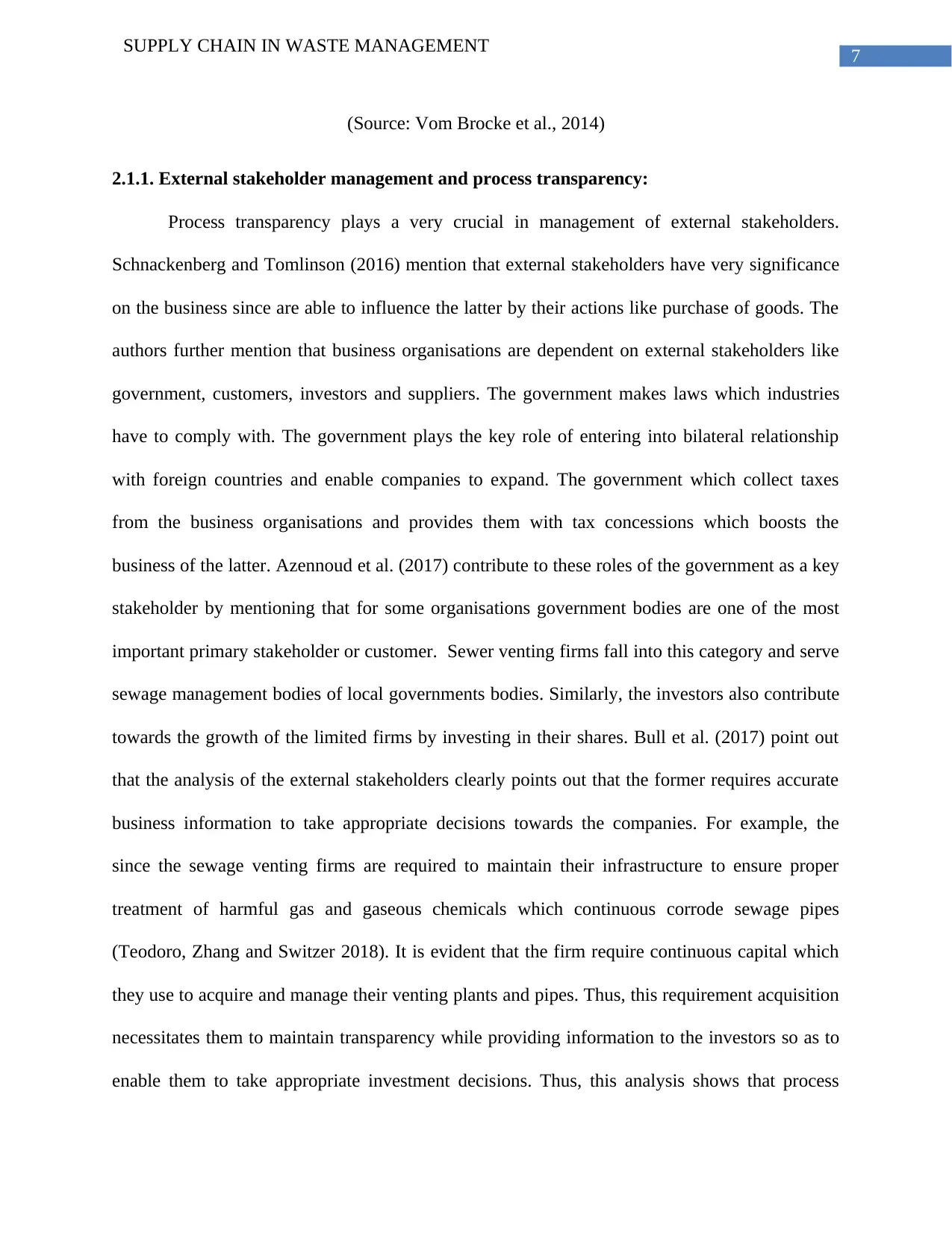
7
SUPPLY CHAIN IN WASTE MANAGEMENT
(Source: Vom Brocke et al., 2014)
2.1.1. External stakeholder management and process transparency:
Process transparency plays a very crucial in management of external stakeholders.
Schnackenberg and Tomlinson (2016) mention that external stakeholders have very significance
on the business since are able to influence the latter by their actions like purchase of goods. The
authors further mention that business organisations are dependent on external stakeholders like
government, customers, investors and suppliers. The government makes laws which industries
have to comply with. The government plays the key role of entering into bilateral relationship
with foreign countries and enable companies to expand. The government which collect taxes
from the business organisations and provides them with tax concessions which boosts the
business of the latter. Azennoud et al. (2017) contribute to these roles of the government as a key
stakeholder by mentioning that for some organisations government bodies are one of the most
important primary stakeholder or customer. Sewer venting firms fall into this category and serve
sewage management bodies of local governments bodies. Similarly, the investors also contribute
towards the growth of the limited firms by investing in their shares. Bull et al. (2017) point out
that the analysis of the external stakeholders clearly points out that the former requires accurate
business information to take appropriate decisions towards the companies. For example, the
since the sewage venting firms are required to maintain their infrastructure to ensure proper
treatment of harmful gas and gaseous chemicals which continuous corrode sewage pipes
(Teodoro, Zhang and Switzer 2018). It is evident that the firm require continuous capital which
they use to acquire and manage their venting plants and pipes. Thus, this requirement acquisition
necessitates them to maintain transparency while providing information to the investors so as to
enable them to take appropriate investment decisions. Thus, this analysis shows that process
SUPPLY CHAIN IN WASTE MANAGEMENT
(Source: Vom Brocke et al., 2014)
2.1.1. External stakeholder management and process transparency:
Process transparency plays a very crucial in management of external stakeholders.
Schnackenberg and Tomlinson (2016) mention that external stakeholders have very significance
on the business since are able to influence the latter by their actions like purchase of goods. The
authors further mention that business organisations are dependent on external stakeholders like
government, customers, investors and suppliers. The government makes laws which industries
have to comply with. The government plays the key role of entering into bilateral relationship
with foreign countries and enable companies to expand. The government which collect taxes
from the business organisations and provides them with tax concessions which boosts the
business of the latter. Azennoud et al. (2017) contribute to these roles of the government as a key
stakeholder by mentioning that for some organisations government bodies are one of the most
important primary stakeholder or customer. Sewer venting firms fall into this category and serve
sewage management bodies of local governments bodies. Similarly, the investors also contribute
towards the growth of the limited firms by investing in their shares. Bull et al. (2017) point out
that the analysis of the external stakeholders clearly points out that the former requires accurate
business information to take appropriate decisions towards the companies. For example, the
since the sewage venting firms are required to maintain their infrastructure to ensure proper
treatment of harmful gas and gaseous chemicals which continuous corrode sewage pipes
(Teodoro, Zhang and Switzer 2018). It is evident that the firm require continuous capital which
they use to acquire and manage their venting plants and pipes. Thus, this requirement acquisition
necessitates them to maintain transparency while providing information to the investors so as to
enable them to take appropriate investment decisions. Thus, this analysis shows that process
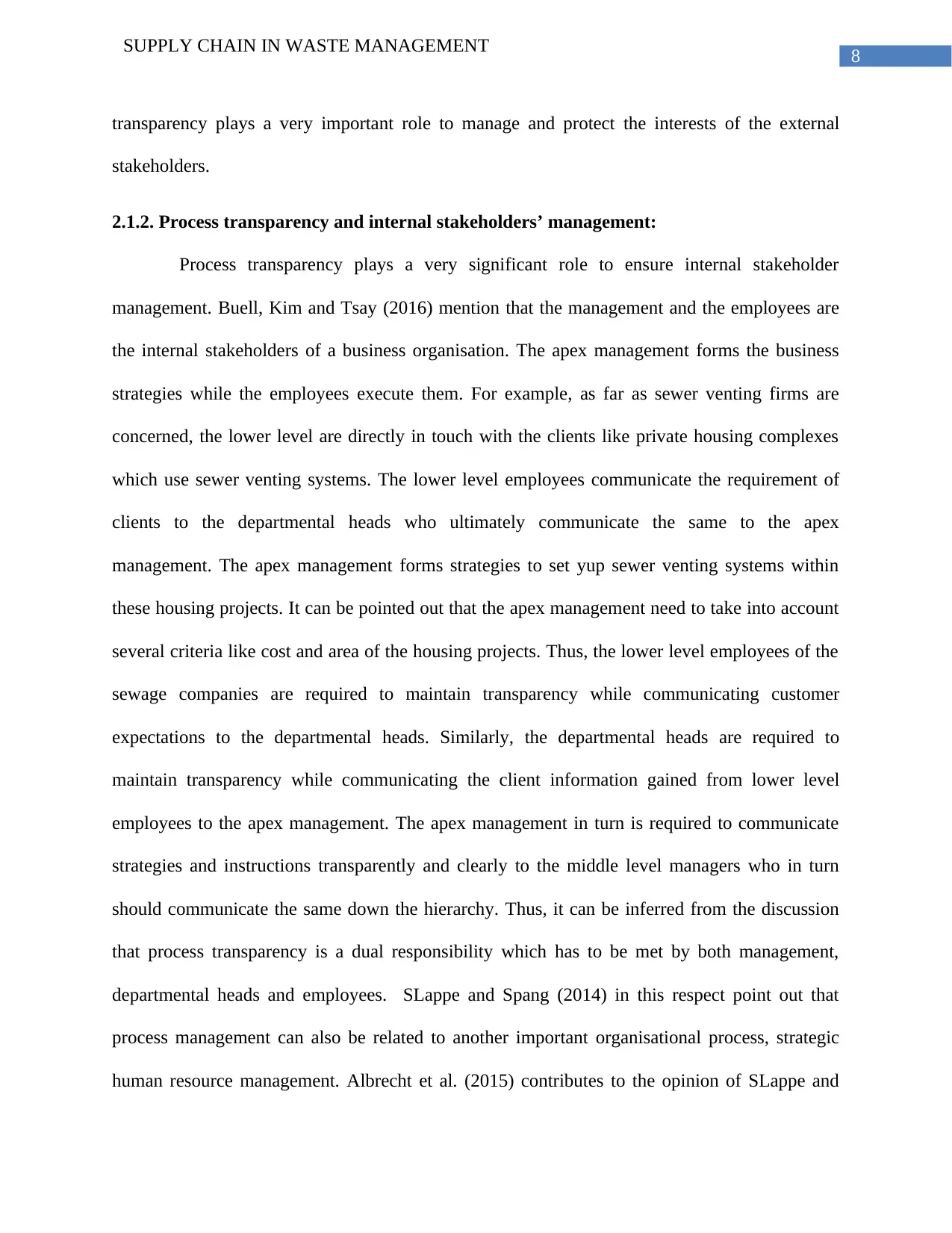
8
SUPPLY CHAIN IN WASTE MANAGEMENT
transparency plays a very important role to manage and protect the interests of the external
stakeholders.
2.1.2. Process transparency and internal stakeholders’ management:
Process transparency plays a very significant role to ensure internal stakeholder
management. Buell, Kim and Tsay (2016) mention that the management and the employees are
the internal stakeholders of a business organisation. The apex management forms the business
strategies while the employees execute them. For example, as far as sewer venting firms are
concerned, the lower level are directly in touch with the clients like private housing complexes
which use sewer venting systems. The lower level employees communicate the requirement of
clients to the departmental heads who ultimately communicate the same to the apex
management. The apex management forms strategies to set yup sewer venting systems within
these housing projects. It can be pointed out that the apex management need to take into account
several criteria like cost and area of the housing projects. Thus, the lower level employees of the
sewage companies are required to maintain transparency while communicating customer
expectations to the departmental heads. Similarly, the departmental heads are required to
maintain transparency while communicating the client information gained from lower level
employees to the apex management. The apex management in turn is required to communicate
strategies and instructions transparently and clearly to the middle level managers who in turn
should communicate the same down the hierarchy. Thus, it can be inferred from the discussion
that process transparency is a dual responsibility which has to be met by both management,
departmental heads and employees. SLappe and Spang (2014) in this respect point out that
process management can also be related to another important organisational process, strategic
human resource management. Albrecht et al. (2015) contributes to the opinion of SLappe and
SUPPLY CHAIN IN WASTE MANAGEMENT
transparency plays a very important role to manage and protect the interests of the external
stakeholders.
2.1.2. Process transparency and internal stakeholders’ management:
Process transparency plays a very significant role to ensure internal stakeholder
management. Buell, Kim and Tsay (2016) mention that the management and the employees are
the internal stakeholders of a business organisation. The apex management forms the business
strategies while the employees execute them. For example, as far as sewer venting firms are
concerned, the lower level are directly in touch with the clients like private housing complexes
which use sewer venting systems. The lower level employees communicate the requirement of
clients to the departmental heads who ultimately communicate the same to the apex
management. The apex management forms strategies to set yup sewer venting systems within
these housing projects. It can be pointed out that the apex management need to take into account
several criteria like cost and area of the housing projects. Thus, the lower level employees of the
sewage companies are required to maintain transparency while communicating customer
expectations to the departmental heads. Similarly, the departmental heads are required to
maintain transparency while communicating the client information gained from lower level
employees to the apex management. The apex management in turn is required to communicate
strategies and instructions transparently and clearly to the middle level managers who in turn
should communicate the same down the hierarchy. Thus, it can be inferred from the discussion
that process transparency is a dual responsibility which has to be met by both management,
departmental heads and employees. SLappe and Spang (2014) in this respect point out that
process management can also be related to another important organisational process, strategic
human resource management. Albrecht et al. (2015) contributes to the opinion of SLappe and
⊘ This is a preview!⊘
Do you want full access?
Subscribe today to unlock all pages.

Trusted by 1+ million students worldwide
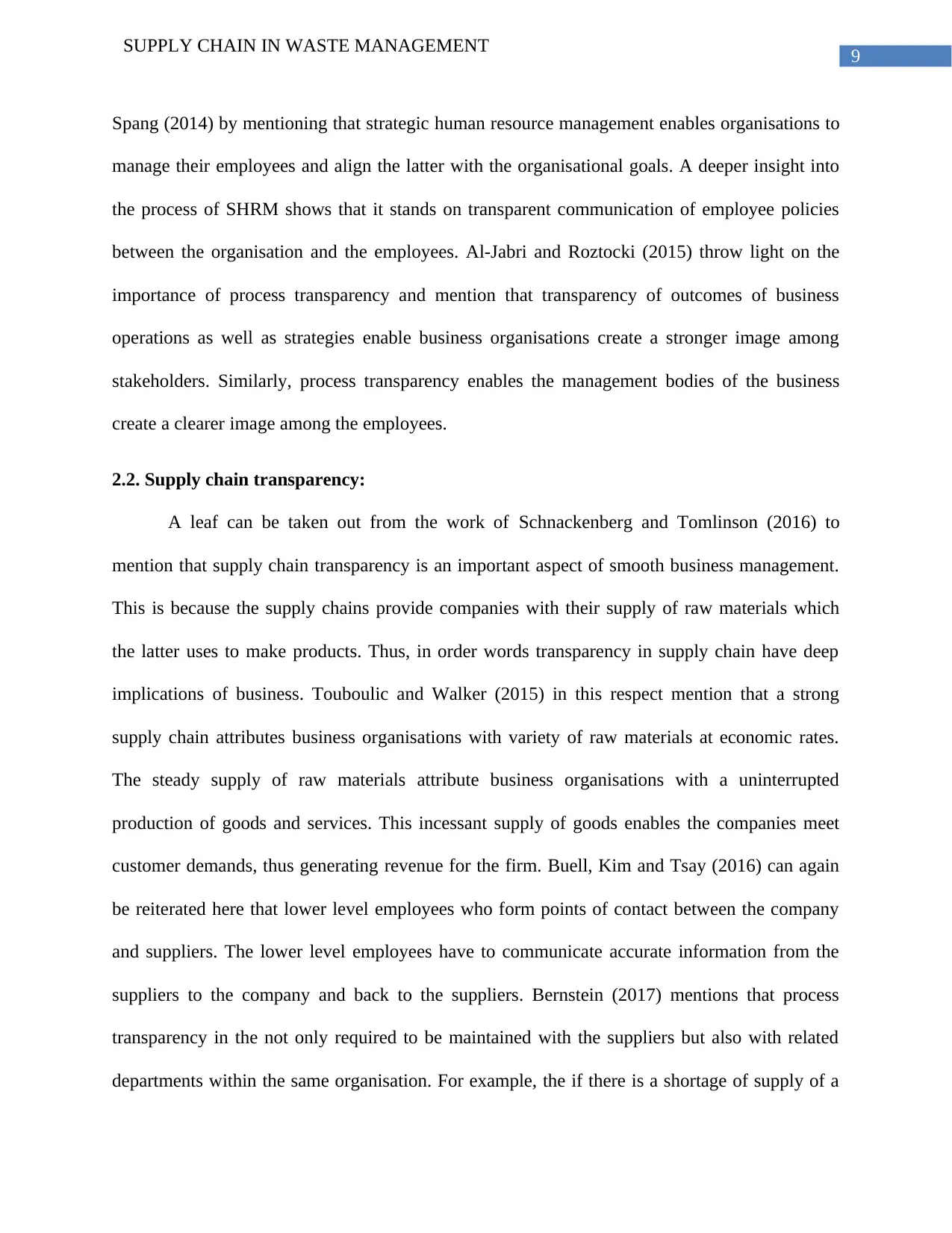
9
SUPPLY CHAIN IN WASTE MANAGEMENT
Spang (2014) by mentioning that strategic human resource management enables organisations to
manage their employees and align the latter with the organisational goals. A deeper insight into
the process of SHRM shows that it stands on transparent communication of employee policies
between the organisation and the employees. Al-Jabri and Roztocki (2015) throw light on the
importance of process transparency and mention that transparency of outcomes of business
operations as well as strategies enable business organisations create a stronger image among
stakeholders. Similarly, process transparency enables the management bodies of the business
create a clearer image among the employees.
2.2. Supply chain transparency:
A leaf can be taken out from the work of Schnackenberg and Tomlinson (2016) to
mention that supply chain transparency is an important aspect of smooth business management.
This is because the supply chains provide companies with their supply of raw materials which
the latter uses to make products. Thus, in order words transparency in supply chain have deep
implications of business. Touboulic and Walker (2015) in this respect mention that a strong
supply chain attributes business organisations with variety of raw materials at economic rates.
The steady supply of raw materials attribute business organisations with a uninterrupted
production of goods and services. This incessant supply of goods enables the companies meet
customer demands, thus generating revenue for the firm. Buell, Kim and Tsay (2016) can again
be reiterated here that lower level employees who form points of contact between the company
and suppliers. The lower level employees have to communicate accurate information from the
suppliers to the company and back to the suppliers. Bernstein (2017) mentions that process
transparency in the not only required to be maintained with the suppliers but also with related
departments within the same organisation. For example, the if there is a shortage of supply of a
SUPPLY CHAIN IN WASTE MANAGEMENT
Spang (2014) by mentioning that strategic human resource management enables organisations to
manage their employees and align the latter with the organisational goals. A deeper insight into
the process of SHRM shows that it stands on transparent communication of employee policies
between the organisation and the employees. Al-Jabri and Roztocki (2015) throw light on the
importance of process transparency and mention that transparency of outcomes of business
operations as well as strategies enable business organisations create a stronger image among
stakeholders. Similarly, process transparency enables the management bodies of the business
create a clearer image among the employees.
2.2. Supply chain transparency:
A leaf can be taken out from the work of Schnackenberg and Tomlinson (2016) to
mention that supply chain transparency is an important aspect of smooth business management.
This is because the supply chains provide companies with their supply of raw materials which
the latter uses to make products. Thus, in order words transparency in supply chain have deep
implications of business. Touboulic and Walker (2015) in this respect mention that a strong
supply chain attributes business organisations with variety of raw materials at economic rates.
The steady supply of raw materials attribute business organisations with a uninterrupted
production of goods and services. This incessant supply of goods enables the companies meet
customer demands, thus generating revenue for the firm. Buell, Kim and Tsay (2016) can again
be reiterated here that lower level employees who form points of contact between the company
and suppliers. The lower level employees have to communicate accurate information from the
suppliers to the company and back to the suppliers. Bernstein (2017) mentions that process
transparency in the not only required to be maintained with the suppliers but also with related
departments within the same organisation. For example, the if there is a shortage of supply of a
Paraphrase This Document
Need a fresh take? Get an instant paraphrase of this document with our AI Paraphraser
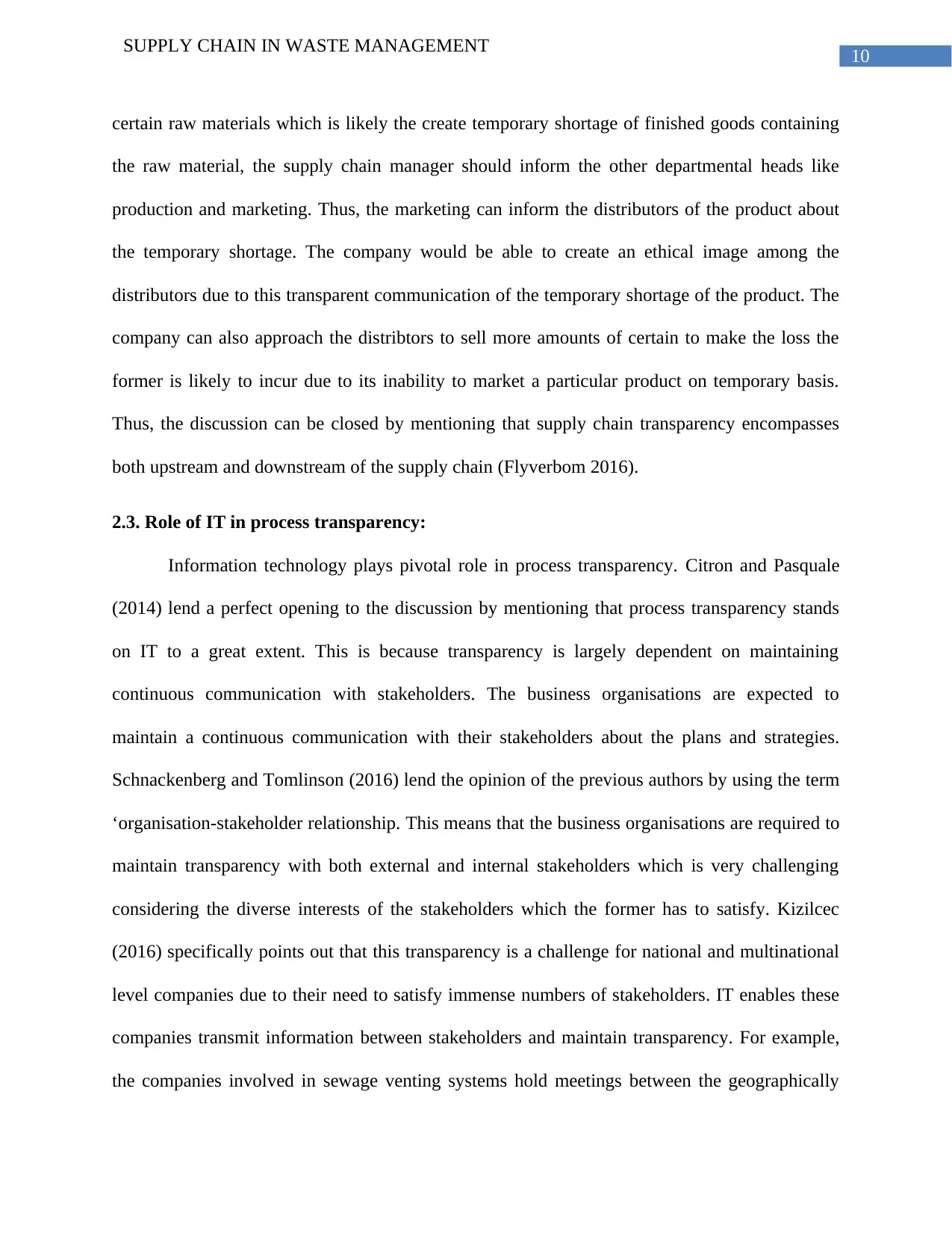
10
SUPPLY CHAIN IN WASTE MANAGEMENT
certain raw materials which is likely the create temporary shortage of finished goods containing
the raw material, the supply chain manager should inform the other departmental heads like
production and marketing. Thus, the marketing can inform the distributors of the product about
the temporary shortage. The company would be able to create an ethical image among the
distributors due to this transparent communication of the temporary shortage of the product. The
company can also approach the distribtors to sell more amounts of certain to make the loss the
former is likely to incur due to its inability to market a particular product on temporary basis.
Thus, the discussion can be closed by mentioning that supply chain transparency encompasses
both upstream and downstream of the supply chain (Flyverbom 2016).
2.3. Role of IT in process transparency:
Information technology plays pivotal role in process transparency. Citron and Pasquale
(2014) lend a perfect opening to the discussion by mentioning that process transparency stands
on IT to a great extent. This is because transparency is largely dependent on maintaining
continuous communication with stakeholders. The business organisations are expected to
maintain a continuous communication with their stakeholders about the plans and strategies.
Schnackenberg and Tomlinson (2016) lend the opinion of the previous authors by using the term
‘organisation-stakeholder relationship. This means that the business organisations are required to
maintain transparency with both external and internal stakeholders which is very challenging
considering the diverse interests of the stakeholders which the former has to satisfy. Kizilcec
(2016) specifically points out that this transparency is a challenge for national and multinational
level companies due to their need to satisfy immense numbers of stakeholders. IT enables these
companies transmit information between stakeholders and maintain transparency. For example,
the companies involved in sewage venting systems hold meetings between the geographically
SUPPLY CHAIN IN WASTE MANAGEMENT
certain raw materials which is likely the create temporary shortage of finished goods containing
the raw material, the supply chain manager should inform the other departmental heads like
production and marketing. Thus, the marketing can inform the distributors of the product about
the temporary shortage. The company would be able to create an ethical image among the
distributors due to this transparent communication of the temporary shortage of the product. The
company can also approach the distribtors to sell more amounts of certain to make the loss the
former is likely to incur due to its inability to market a particular product on temporary basis.
Thus, the discussion can be closed by mentioning that supply chain transparency encompasses
both upstream and downstream of the supply chain (Flyverbom 2016).
2.3. Role of IT in process transparency:
Information technology plays pivotal role in process transparency. Citron and Pasquale
(2014) lend a perfect opening to the discussion by mentioning that process transparency stands
on IT to a great extent. This is because transparency is largely dependent on maintaining
continuous communication with stakeholders. The business organisations are expected to
maintain a continuous communication with their stakeholders about the plans and strategies.
Schnackenberg and Tomlinson (2016) lend the opinion of the previous authors by using the term
‘organisation-stakeholder relationship. This means that the business organisations are required to
maintain transparency with both external and internal stakeholders which is very challenging
considering the diverse interests of the stakeholders which the former has to satisfy. Kizilcec
(2016) specifically points out that this transparency is a challenge for national and multinational
level companies due to their need to satisfy immense numbers of stakeholders. IT enables these
companies transmit information between stakeholders and maintain transparency. For example,
the companies involved in sewage venting systems hold meetings between the geographically
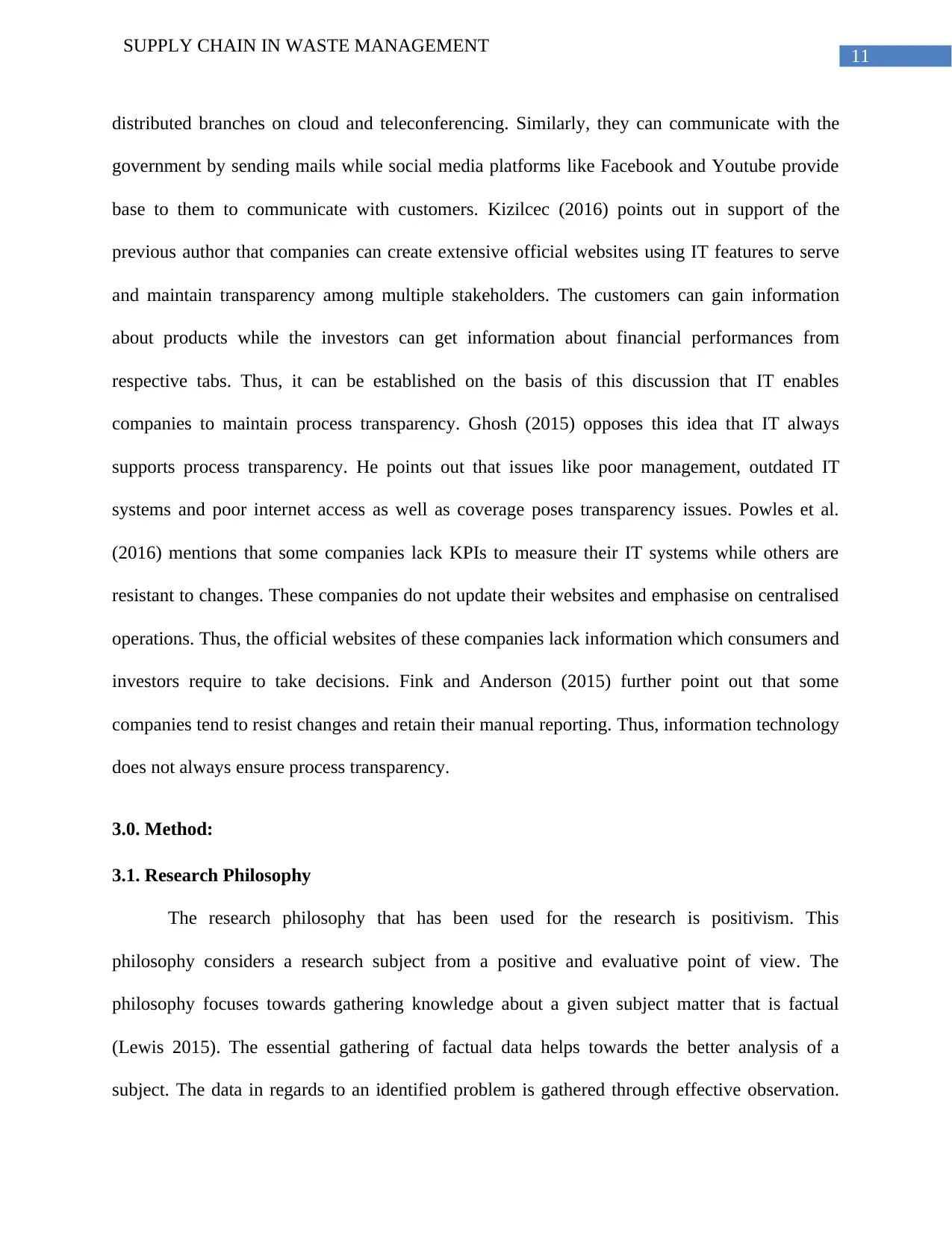
11
SUPPLY CHAIN IN WASTE MANAGEMENT
distributed branches on cloud and teleconferencing. Similarly, they can communicate with the
government by sending mails while social media platforms like Facebook and Youtube provide
base to them to communicate with customers. Kizilcec (2016) points out in support of the
previous author that companies can create extensive official websites using IT features to serve
and maintain transparency among multiple stakeholders. The customers can gain information
about products while the investors can get information about financial performances from
respective tabs. Thus, it can be established on the basis of this discussion that IT enables
companies to maintain process transparency. Ghosh (2015) opposes this idea that IT always
supports process transparency. He points out that issues like poor management, outdated IT
systems and poor internet access as well as coverage poses transparency issues. Powles et al.
(2016) mentions that some companies lack KPIs to measure their IT systems while others are
resistant to changes. These companies do not update their websites and emphasise on centralised
operations. Thus, the official websites of these companies lack information which consumers and
investors require to take decisions. Fink and Anderson (2015) further point out that some
companies tend to resist changes and retain their manual reporting. Thus, information technology
does not always ensure process transparency.
3.0. Method:
3.1. Research Philosophy
The research philosophy that has been used for the research is positivism. This
philosophy considers a research subject from a positive and evaluative point of view. The
philosophy focuses towards gathering knowledge about a given subject matter that is factual
(Lewis 2015). The essential gathering of factual data helps towards the better analysis of a
subject. The data in regards to an identified problem is gathered through effective observation.
SUPPLY CHAIN IN WASTE MANAGEMENT
distributed branches on cloud and teleconferencing. Similarly, they can communicate with the
government by sending mails while social media platforms like Facebook and Youtube provide
base to them to communicate with customers. Kizilcec (2016) points out in support of the
previous author that companies can create extensive official websites using IT features to serve
and maintain transparency among multiple stakeholders. The customers can gain information
about products while the investors can get information about financial performances from
respective tabs. Thus, it can be established on the basis of this discussion that IT enables
companies to maintain process transparency. Ghosh (2015) opposes this idea that IT always
supports process transparency. He points out that issues like poor management, outdated IT
systems and poor internet access as well as coverage poses transparency issues. Powles et al.
(2016) mentions that some companies lack KPIs to measure their IT systems while others are
resistant to changes. These companies do not update their websites and emphasise on centralised
operations. Thus, the official websites of these companies lack information which consumers and
investors require to take decisions. Fink and Anderson (2015) further point out that some
companies tend to resist changes and retain their manual reporting. Thus, information technology
does not always ensure process transparency.
3.0. Method:
3.1. Research Philosophy
The research philosophy that has been used for the research is positivism. This
philosophy considers a research subject from a positive and evaluative point of view. The
philosophy focuses towards gathering knowledge about a given subject matter that is factual
(Lewis 2015). The essential gathering of factual data helps towards the better analysis of a
subject. The data in regards to an identified problem is gathered through effective observation.
⊘ This is a preview!⊘
Do you want full access?
Subscribe today to unlock all pages.

Trusted by 1+ million students worldwide
1 out of 30
Related Documents
Your All-in-One AI-Powered Toolkit for Academic Success.
+13062052269
info@desklib.com
Available 24*7 on WhatsApp / Email
![[object Object]](/_next/static/media/star-bottom.7253800d.svg)
Unlock your academic potential
Copyright © 2020–2025 A2Z Services. All Rights Reserved. Developed and managed by ZUCOL.





